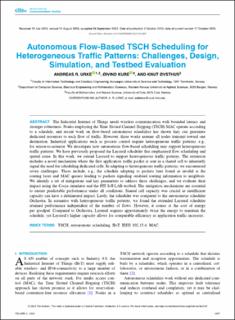| dc.contributor.author | Urke, Andreas Ramstad | |
| dc.contributor.author | Kure, Øivind | |
| dc.contributor.author | Øvsthus, Knut | |
| dc.date.accessioned | 2023-12-06T08:41:45Z | |
| dc.date.available | 2023-12-06T08:41:45Z | |
| dc.date.created | 2023-11-06T21:37:21Z | |
| dc.date.issued | 2023 | |
| dc.identifier.citation | IEEE Open Journal of the Communications Society. 2023, 4 2357-2372. | en_US |
| dc.identifier.issn | 2644-125X | |
| dc.identifier.uri | https://hdl.handle.net/11250/3106156 | |
| dc.description.abstract | The Industrial Internet of Things needs wireless communication with bounded latency and stronger robustness. Nodes employing the Time Slotted Channel Hopping (TSCH) MAC operate according to a schedule, and recent work on flow-based autonomous schedulers has shown they can guarantee dedicated resources to each flow of traffic. However, these works assume all nodes transmit toward one destination. Industrial applications such as process control require heterogeneous traffic patterns, e.g., for sensor-to-actuator. We investigate how autonomous flow-based scheduling may support heterogeneous traffic patterns. We have previously proposed the Layered scheduler that emphasized flow scheduling and spatial reuse. In this work, we extend Layered to support heterogeneous traffic patterns. The extension includes a novel mechanism where the first application traffic packet is sent in a shared cell to inherently signal the need for scheduling dedicated cells. In adapting to heterogeneous traffic patterns, we encountered seven challenges. These include, e.g., the schedule adapting to packets later found as invalid at the routing layer and MAC queues leading to packets signaling outdated routing information to neighbors. We identify a set of mitigations and key parameters to address these challenges, and we evaluate their impact using the Cooja simulator and the FIT IoT-LAB testbed. The mitigation mechanisms are essential to ensure predictable performance under all conditions. Shared cell capacity was crucial as insufficient capacity can have a detrimental impact. Lastly, the scheduler was compared to the autonomous scheduler Orchestra. In scenarios with heterogeneous traffic patterns, we found the extended Layered scheduler retained performance independent of the number of flows. However, it comes at the cost of energy per goodput. Compared to Orchestra, Layered requires approximately twice the energy to maintain the schedule, yet Layered’s higher capacity allows for comparable ef... | en_US |
| dc.language.iso | eng | en_US |
| dc.publisher | IEEE | en_US |
| dc.rights | Navngivelse 4.0 Internasjonal | * |
| dc.rights.uri | http://creativecommons.org/licenses/by/4.0/deed.no | * |
| dc.title | Autonomous Flow-Based TSCH Scheduling for Heterogeneous Traffic Patterns: Challenges, Design, Simulation, and Testbed Evaluation | en_US |
| dc.title.alternative | Autonomous Flow-Based TSCH Scheduling for Heterogeneous Traffic Patterns: Challenges, Design, Simulation, and Testbed Evaluation | en_US |
| dc.type | Peer reviewed | en_US |
| dc.type | Journal article | en_US |
| dc.description.version | publishedVersion | en_US |
| dc.subject.nsi | VDP::Informasjons- og kommunikasjonsteknologi: 550 | en_US |
| dc.subject.nsi | VDP::Information and communication technology: 550 | en_US |
| dc.source.pagenumber | 2357-2372 | en_US |
| dc.source.volume | 4 | en_US |
| dc.source.journal | IEEE Open Journal of the Communications Society | en_US |
| dc.identifier.doi | 10.1109/OJCOMS.2023.3321405 | |
| dc.identifier.cristin | 2192952 | |
| cristin.ispublished | true | |
| cristin.fulltext | original | |
| cristin.qualitycode | 1 | |

